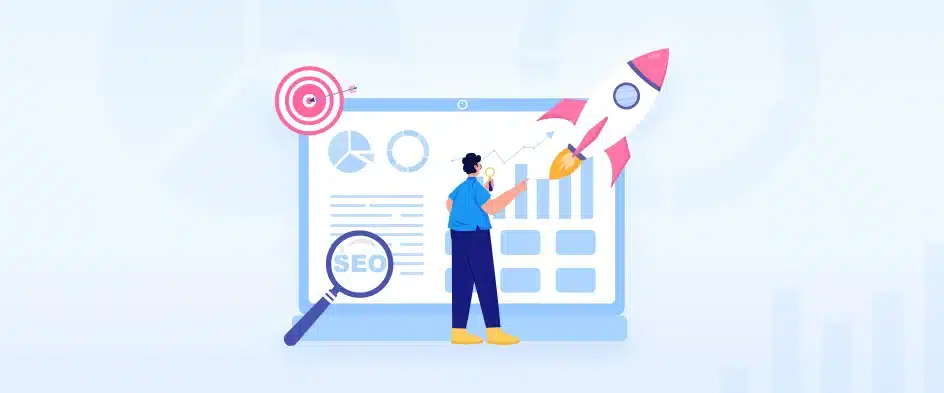The Importance of SEO in Web Design: A Complete Guide

- 10 Minutes to read
Table of Content
- What is SEO?
- Importance of SEO in Web Design
- How to Implement SEO in Web Design?
- Best Practices for SEO in Web Design
- Conclusion
- FAQs on the Importance of SEO in Web Design
The importance of SEO in web design and development isn’t easily fathomable. It can take a website from being unknown to being well-known in the digital world. A website designed well and optimized for search engines has the potential to bring in more organic traffic, make user experience better, and ultimately increase conversions.
A website that looks stunning might get noticed, but without proper SEO practices, it could have difficulty standing out in a crowded online space. By using SEO-friendly tactics, such as optimizing meta tags, adding relevant keywords, and improving site speed, the top web design companies can make their websites attractive and rank higher in search engine results.
In this informative piece, we’ll see what SEO is, how it impacts web design, and how you can implement it effectively. So, let’s begin.
What is SEO?
Search Engine Optimization, also called SEO, is the method of customizing and optimizing a website to boost its presence and rank on search engine results. Various strategies and techniques help search engines comprehend the content of a website better. Thus making it more likely to appear higher up in search results. SEO is key in web design. It can create organic traffic, boost brand visibility, and ultimately drive conversions.
When it comes to web design, it’s pivotal to include SEO from the beginning. Implementing SEO-friendly design elements such as clear navigation, fast loading speeds, mobile readiness, and user-friendly layouts can give websites an edge.
These factors not only enhance the user experience but also demonstrate to search engines that the site is reliable and relevant. By focusing on SEO in web design, businesses can ensure their website is easily discoverable by potential customers.
Furthermore, SEO in web design goes beyond technical elements; it also includes creating top-notch and optimized content. By blending targeted keywords into the website’s pages, headings, meta descriptions, and image alt tags, websites can reach higher ranks for relevant search queries. Plus, optimizing content with well-structured HTML tags and using schema markup can further improve the website’s visibility in search results.
SEO is one of the crucial elements in the web design best practices. So, when designing your website, make sure to implement this strategy or consult with the top SEO agencies. It will guarantee your website a steady stream of organic traffic.
Importance of SEO in Web Design
SEO is a key part of any website’s design and layout. It focuses on enhancing the user experience, increasing the visibility in search engines, and driving organic traffic. Let’s delve into these benefits a little further.
Enhances User Experience
Enhancing user experience is a must-do in web design. By focusing on this, a website can perform better and keep visitors engaged.
- Intuitive Navigation: An SEO-friendly design allows smooth navigation for users. They can easily find what they need.
- Faster Loading Speed: A well-optimized website loads quickly. This improves the experience and keeps visitors engaged.
- Mobile Responsiveness: Most people use mobile devices to access websites. Responsive design adapts to different screen sizes, enhancing the experience.
- Easier Content Consumption: Structured content makes it easier for users to digest information, improving their overall browsing experience.
- Effective Call-to-Action: Strategic call-to-action elements guide users toward desired actions. This creates a seamless journey and elevates their experience.
SEO-friendly web design offers additional benefits. These include improved search engine rankings, increased organic traffic, and higher conversion rates. All these help enhance user experience.
Increases Visibility in Search Engines
One of the most significant benefits of SEO in web design is its potential to raise visibility in search engines. Through SEO, sites can enhance their chances of being spotted by online users.
- SEO can give websites an advantage in SERP rankings. This implies that when users look for related keywords or phrases, the website has a better chance of appearing close to the top of the list. This increased visibility leads to more organic traffic and more potential to connect with people.
- SEO helps sites draw targeted traffic. By adjusting content and structure to match user intent and preferences, search engine algorithms can more easily recognize its relevance. Therefore, the website appears before people who are looking for info or solutions related to its offerings.
- Incorporating effective SEO practices upgrades the user experience. When a website is optimized for speed, mobile-friendliness, and easy navigation, it gives a good impression on users. This results in longer time spent on the site and greater possibilities for conversions or other desired actions.
One further advantage of using solid SEO methods in web design is improved brand credibility and authority. When a website often appears in related search results and provides valuable content or products/services, it becomes a trusted source in its industry.
Drives Organic Traffic
SEO can help increase organic traffic by optimizing content with relevant keywords. According to an Ahrefs report, over 53% of all traffic on a website comes from organic search aided by search engine optimization.
When a site ranks higher on the search pages, it is more likely to be seen by users searching for relevant keywords. That can lead to an increase in organic traffic to the website.
These are just a few points that highlight the importance of SEO in web design. If you want these benefits for your website, consult with the top SEO companies. But if you want to proceed further yourself, let’s see the implementation process.
How to Implement SEO in Web Design?
If you want to boost your website’s search visibility and drive organic traffic, you will need to implement SEO in web design. That includes keyword research and optimization, optimizing site structure and navigation, creating SEO-friendly URLs, optimizing page titles and meta descriptions, and optimizing images and multimedia.
Keyword Research and Optimization
Keyword research and optimization are essential to get maximum visibility on search engines. By finding the right keywords, you can gain targeted organic traffic and boost your website’s ranking.
Start by developing a keyword research strategy. Brainstorm topics and themes related to your business. Then, use tools like Google Keyword Planner or SEMrush to find keywords with high search volume but low competition.
Analyze your competitors’ websites to see which keywords they are targeting. This can give you insights into the keywords that are working in your industry. Make sure they are relevant to your business and content strategy.
Think about user intent when choosing keywords. Understand what people are searching for when entering certain words or phrases into search engines. This will help you tailor your content.
Long-tail keywords are longer and more specific phrases. These usually have lower competition but higher conversion rates.
Once you have identified the right keywords, optimize them throughout your website. Include them in page titles, meta descriptions, headings, and content. Avoid over-optimization or keyword stuffing, or you may be penalized by search engines.
Optimize Site Structure and Navigation
Another critical part of SEO in web design, site structure optimization, ensures a better layout on the website. Here’s how you proceed:
- Organize pages with a clear hierarchy using categories and subcategories.
- Provide easy access to user-friendly navigation menus, including dropdowns, breadcrumbs, and search bars.
- Link pages within the website to build connections between sections.
- Make sites responsive and mobile-friendly.
- Design for optimal structure and navigation for a better user experience.
The best web design agencies recognize the importance of structured website layout. To that end, they ensure intuitive menus, hierarchical structures, and internal linking strategies.
Create SEO-friendly URLs
When creating SEO-friendly URLs, it is also important to consider the overall structure of your website. Your URLs should be consistent and easy to navigate.
- Use keywords. Add them to URLs to help search engines understand the page.
- Keep it short. Short URLs usually rank better in search engines. Long URLs are hard for search engines and people to remember.
- Use hyphens. Instead of spaces or underscores, use hyphens to separate words. This makes it easier for users and search engines.
- Remove stop words. Take out stop words like “a,” “the,” and “and” from the URLs. This makes the URL more keyword-focused.
- Be consistent. Keep the URL structure the same throughout the website. This helps users and search engines to understand the site structure.
- Don’t go overboard. Include the main topic of the page without being overly repetitive or long.
By following these best practices, you can create SEO-friendly URLs that will help your website rank higher in search results and attract more organic traffic.
Optimize Page Titles and Meta Descriptions
Page titles and meta descriptions are among the most important SEO elements. They are the first things that users see when they search for your website in the SERPs, so it is important to make sure they are optimized.
Here are some tips for optimizing your page titles and meta descriptions:
- Keep it brief: Titles should be under 60 characters & descriptions under 160 characters. This way, they’ll be fully visible in SERPs.
- Include relevant keywords: Reflect the content & optimize visibility in organic search results.
- Write compelling copy: Don’t compromise on quality; craft captivating titles & descriptions that arouse curiosity.
- Offer unique info: Each page should have distinct titles & descriptions that accurately reflect their content.
- Monitor & update: Analyze metrics such as CTR & make adjustments to maximize impact.
Additionally, make sure to avoid content duplication and keyword stuffing and opt for rich snippets.
Optimize Images and Multimedia
If the images and other media don’t open and load well and quickly, it may put the users off. So, make sure to optimize images and multimedia as a part of the SEO implementation. Here’s how you go forth.
- Compress images to reduce file size and make web pages load faster. Use online tools or software.
- Name files accurately with relevant keywords rather than generic names like ‘image123.jpg’.
- Include alt tags and captions with relevant keywords. Alt tags are important for visually impaired users or when images fail to load.
Also, make sure to use lazy loading techniques to prioritize visible content and compress videos to reduce file size. Finally, it utilizes responsive design techniques, providing optimal user experience.
If you want to benefit from SEO in web design through these implementations, you may opt for the best SEO service partners.
Best Practices for SEO in Web Design
To ensure your web design is optimized for SEO, you may implement best practices like mobile optimization, page speed optimization, user-friendly design and layout, and quality content creation. Let’s discuss them one by one.
Mobile Optimization
| Aspect | Description |
|---|---|
| Responsive Design | Making a website design that adjusts to fit different gadgets |
| Fast Loading Time | Optimizing images, code & files to reduce loading time & improve user experience |
| Thumb-Friendly Layout | Designing clickable elements that are accessible with a thumb touch |
For improved Mobile Optimization, think of stuff like responsive design. This allows the website to adjust to different device screen sizes. Also, optimize loading time by compressing images and minimizing code. This will greatly improve user experience.
Furthermore, create a thumb-friendly layout with clickable elements. This ensures easy navigation on mobile devices without zooming or pinching.
Page Speed Optimization
Page speed optimization is the process of improving the loading speed of a web page. That is important because users are more likely to bounce from a slow-loading page, and search engines rank faster pages higher in the SERPs.
- To minimize HTTP requests, reduce the elements such as images, scripts, and stylesheets on your page. This will help shorten loading times.
- Enable browser caching by setting expiration headers for static resources. This will allow the browser to store certain files locally, reducing the need to fetch them from the server each time.
- Compress content with GZIP compression. This will reduce the file size of your resources, making them quicker to download.
- Optimize images by resizing and compressing them without compromising quality. This will help reduce the size of your image files, resulting in faster loading times.
- Minify CSS and JavaScript by removing unnecessary characters, comments, and white spaces. This will help reduce the file size of your CSS and JavaScript files, making them quicker to load.
- Consider using a CDN (Content Delivery Network) to distribute files across servers worldwide. This can help improve the delivery speed of your content to users in different geographic locations.
Also, monitor performance with tools like Google PageSpeed or GTmetrix to identify areas for improvement. These tools can provide insights and suggestions on how to further optimize your page speed.
User-friendly Design and Layout
Design and layout should be user-friendly for successful web design. This ensures visitors have a pleasant experience and locate the info they want quickly.
To make that happen:
- Keep the design simple and uncluttered. Utilize clear headings, sections, and menus to guide people through the website easily.
- Ensure your website is optimized for different devices, including desktops, tablets, and smartphones.
- Maintain consistent elements such as colors, fonts, and buttons for a professional look.
Also, include interactive features like dropdown menus and search bars to boost user experience. By focusing on user-friendliness in your web design decisions, you can increase user engagement and maximize SEO results.
Quality Content Creation
Quality content creation is a must for successful web design. Crafting engaging and informative content that appeals to the target audience is essential. By providing valuable info and addressing their needs, businesses can prove their credibility and draw more visitors.
This part of effective SEO in web design is quite significant as it directs traffic to the website, enhances user interaction and boosts search engine rankings.
Creating quality content involves more than just using keywords. It needs proper research and understanding of the target audience’s interests and preferences. Incorporating relevant and insightful info helps businesses present themselves as experts and build trust with their readers.
To ensure quality content creation, businesses should:
- Do keyword research: Identify popular search terms related to the business niche to make sure the content meets users’ search intent.
- Utilize a clear structure: Organize the content into headings, subheadings, and bullet points for readers to skim through and find relevant info quickly.
- Include visuals: Images, infographics, or videos make the content more visually appealing and enhance user experience.
- Optimize for SEO: While creating quality content is key, optimizing it for search engines is equally important. Incorporating relevant keywords naturally throughout the content boosts visibility in search engine results pages (SERPs).
By following these tips, businesses can create quality content that not only engages users but also enhances their website’s search engine rankings. Remember, providing valuable information is the key to attracting and retaining users in today’s competitive online world.If you want to implement these SEO best practices in web design on your site, I suggest you consult with the best web design partners.
Conclusion
Web design is a critical part of developing any website, and one of the elements that can take the design to the next level is SEO. Optimizing your website for search engines can boost visibility and organic traffic.
A website that is designed well and has effective SEO will rank highly on search engine results pages. This means more people will find your site, possibly becoming potential customers.
- SEO elements in web design help search engine crawlers understand and index your site. That ensures a better user experience.
- An SEO-friendly web design offers users smooth navigation so they better understand the content on your website.
- Optimizing the website for mobile will ensure more organic traffic.
So, if you want to benefit from SEO in web design, make sure to find the best agencies or follow this blog to the tee.
FAQs on the Importance of SEO in Web Design
1. Why is SEO important in web design?
SEO is important in web design because it helps to attract organic traffic from search engines, improves user experience, and increases the chances of ranking higher in search engine results.
2. Can I do SEO without considering web design?
While it is possible to implement some SEO practices without web design considerations, a well-designed website that adheres to SEO guidelines has a better chance of achieving higher rankings and attracting organic traffic.
3. How long does it take to see results from SEO efforts?
The time it takes to see results from SEO efforts can vary depending on various factors, such as the competitiveness of keywords, website optimization, and the search engine’s crawling frequency. Generally, it may take several weeks to months to observe noticeable improvements.



